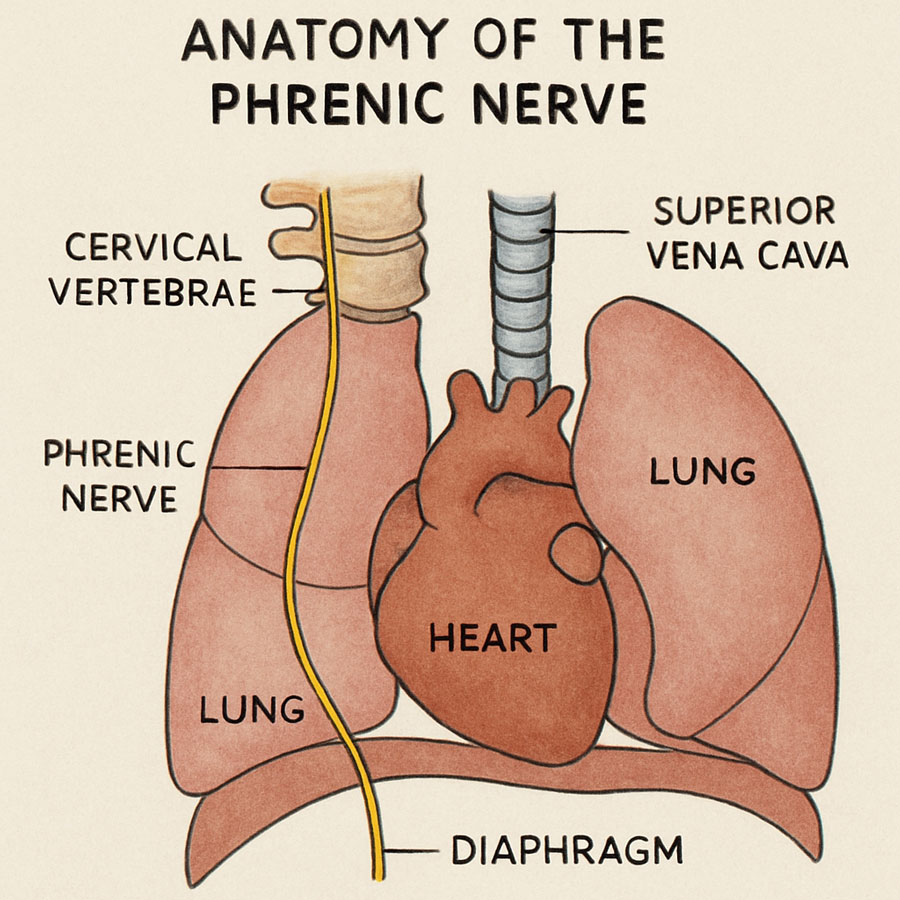Understanding Phrenic Nerve Damage and Malpractice
Phrenic nerve damage can have serious consequences. It affects the diaphragm, which is crucial for breathing.
Understanding the causes and symptoms is vital for early detection. This knowledge can prevent further complications.
Surgical errors and medical negligence are common causes of phrenic nerve damage. These can lead to malpractice claims.
If you suspect nerve damage, seek medical advice promptly. Early intervention can improve outcomes and quality of life.
Legal guidance is also important. A malpractice attorney can help you navigate the complexities of a claim.
What Is the Phrenic Nerve and Why Is It Important?
The phrenic nerve plays a key role in breathing. This vital nerve runs from the neck to the diaphragm.
The diaphragm is the muscle that separates the chest and abdomen. It contracts and relaxes to allow breathing.
If the phrenic nerve is damaged, breathing becomes difficult. This can lead to serious respiratory issues.
Functions of the Phrenic Nerve:
- Controls diaphragm movements
- Facilitates breathing
- Supports respiratory function

Damage to this nerve can paralyze the diaphragm. This affects your ability to breathe normally and requires medical attention.
Having a clear understanding of this nerve’s importance can help in recognizing symptoms early. Early recognition can prompt timely medical intervention.
Causes and Risk Factors for Phrenic Nerve Damage
Phrenic nerve damage may arise from several causes. Surgical procedures near the neck or chest are common culprits.
Errors during surgery can harm this sensitive nerve. Cardiac, thoracic, or neck surgeries may pose significant risks.
Trauma is another potential cause of damage. Accidents causing neck or chest injuries often affect the nerve.
Medical negligence or mistakes in diagnosis can also lead to phrenic nerve injury. Delays in diagnosing can worsen the problem.
Common Causes:
- Surgical errors
- Traumatic injuries
- Misdiagnosis or delayed diagnosis
Certain factors increase risk, such as prior surgeries in the affected area. It is crucial to be aware of these risks.
Individuals should discuss potential risks with their surgeons. Informed consent is important before any medical procedure.
Understanding these risk factors helps in taking preventive measures. This awareness can lead to better healthcare outcomes.
Recognizing Nerve Damage Symptoms
Identifying phrenic nerve damage early is crucial for effective treatment. Recognizing symptoms promptly can prevent further complications and aid in recovery.
Common symptoms often include respiratory issues. Shortness of breath is a notable sign that the diaphragm might be compromised.
Patients may also experience frequent hiccups. This seemingly minor symptom can be a clue to underlying nerve issues.
Other symptoms could be less obvious. Some individuals report shoulder pain or discomfort without clear explanation.
Watch for These Symptoms:
- Shortness of breath
- Persistent hiccups
- Unexplained shoulder pain
Nerve damage symptoms can vary in severity. What starts as mild discomfort might worsen over time if untreated.
It’s important to seek medical attention if these symptoms appear. Early diagnosis and intervention can significantly improve outcomes.

How Is Phrenic Nerve Damage Diagnosed?
Diagnosing phrenic nerve damage involves a series of tests. Medical professionals use these to pinpoint the exact issue.
Electromyography (EMG) is a common diagnostic tool. It measures muscle response to nerve stimulation. This helps assess the functioning of the phrenic nerve.
Doctors may also perform nerve conduction studies. These tests evaluate how efficiently electrical signals move through nerves.
Common Diagnostic Tests Include:
- Electromyography (EMG)
- Nerve conduction studies
Additional imaging tests might be employed. These can reveal structural issues affecting the nerve. Early diagnosis is key to managing symptoms and planning treatment. Recognizing damage promptly can make a significant difference in recovery outcomes.
Treatment Options and Prognosis
Treatment for phrenic nerve damage varies. It depends on the severity of the injury and symptoms. Early intervention can improve outcomes significantly.
Physical therapy is a common starting point. It focuses on strengthening the diaphragm and improving breathing. This can help alleviate some of the respiratory issues.
Surgical options are available for severe cases. Nerve repair surgeries aim to restore function. Diaphragmatic pacing may also be considered.
Treatment Options Include:
- Physical therapy
- Surgical repair
- Diaphragmatic pacing
Prognosis largely depends on early treatment and the extent of the damage. With proper care, many patients see symptom improvement. However, some cases result in persistent challenges. A multidisciplinary approach can aid recovery and enhance quality of life. Ongoing medical support is crucial for managing long-term outcomes.
When Is Phrenic Nerve Damage Considered Malpractice?
Phrenic nerve damage isn’t always malpractice. To qualify, the damage must result from negligence or errors. This involves a breach of the medical standard of care.
Typically, malpractice occurs if a healthcare provider fails to act as a competent professional would. Surgical errors near the neck or chest frequently lead to such cases. Misdiagnosis or delayed diagnosis may also contribute.
To consider phrenic nerve damage as malpractice, certain conditions are met. These include:
- Established doctor-patient relationship
- Breach of standard care
- Causal link between negligence and damage
- Proof of resulting damages
An example might include an unreported complication during surgery. If this oversight results in nerve damage, malpractice might be established. Adequate records and evidence are critical for such claims.
It’s vital for patients to understand their rights. Consulting with a legal professional helps clarify if a valid malpractice case exists. This can guide them on the steps to seek compensation and justice.
Building a Malpractice Claim: What You Need to Prove
Establishing a malpractice claim involves several key components. The plaintiff must demonstrate that the healthcare provider breached a duty of care. This breach must directly cause the phrenic nerve damage.
The process requires clear documentation and evidence. Records should highlight how the standard of care was not met. It’s crucial to illustrate how this failure caused harm or deterioration.
Several elements must be proven for a successful claim, including:
- Existence of a doctor-patient relationship
- Provider’s duty to adhere to standard care
- Breach of this duty
- Direct link between the breach and the injury
- Measurable damages incurred as a result
Expert testimony is often critical in malpractice claims. These experts clarify medical standards and breaches. Their input can substantiate the claim and support the injured party’s case.
Thorough preparation is essential. Gathering strong evidence and obtaining professional opinions can significantly enhance the credibility of a malpractice claim.
The Role of a Malpractice Attorney
A malpractice attorney is crucial in navigating complex legal processes. They provide expert advice on the feasibility of a claim. Their knowledge helps determine whether negligence occurred.
Attorneys assist in gathering evidence and medical records. They ensure all documentation meets legal standards. Proper preparation strengthens the case immensely.
Attorneys handle the following tasks:
- Evaluating medical records
- Consulting with medical experts
- Negotiating settlements or representing in court
They guide clients through each step, offering peace of mind. With their expertise, patients are more equipped to pursue justice. An attorney’s role is pivotal in achieving a favorable legal outcome. They are invaluable allies in malpractice claims.
Compensation and Legal Outcomes
Compensation in phrenic nerve damage cases varies widely. It often covers several costs incurred by the patient. Financial relief for medical expenses and loss of income is common.
In addition to tangible costs, emotional suffering is considered. Pain, reduced quality of life, and mental distress are significant factors. These intangibles profoundly impact the affected individuals.
Legal outcomes depend on the case details. Successful claims can include:
- Medical expenses
- Lost wages
- Pain and suffering
Each case is unique, and outcomes can differ markedly. Compensation aims to restore affected individuals’ dignity and health. Proper legal guidance is vital in achieving fair results.
Steps to Take If You Suspect Malpractice
If you suspect malpractice related to phrenic nerve damage, take immediate action. Prompt steps increase the chance of a favorable outcome.
First, gather all relevant medical records and documents. These will be crucial for building your case. Consulting with a malpractice attorney early on is advisable.
Steps to consider include:
- Collecting medical records
- Seeking a second opinion
- Contacting a malpractice attorney
Proactive measures can significantly impact the success of your claim. Always approach the situation with clarity and determination.
Resources and Support for Patients
Patients dealing with phrenic nerve damage have access to valuable resources. These can offer both emotional and practical support throughout recovery.
Explore various support options to aid your journey:
- Online support groups for shared experiences
- Educational materials on nerve damage
- Legal aid services for malpractice cases
Utilizing these resources can significantly enhance your coping strategies and recovery process.
Conclusion: Protecting Your Health and Legal Rights
Understanding phrenic nerve damage is crucial for safeguarding your well-being. Prompt medical attention can prevent complications and improve outcomes.
If you suspect malpractice, knowing your legal rights is essential. One of our experienced medical malpractice attorneys at Goldberg & Loren can guide you through the legal process, helping ensure you receive fair compensation and justice. Call us at 1-888-352-9243 for a free consultation.

